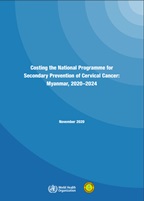
WHO Cervical Cancer Prevention and Control Costing (C4P) Tool
Development
An early version of the C4P-HPV tool was used for Gavi-supported demonstration projects on sub-national level costing. A version was then developed for national scale-up of HPV vaccination, which was successfully field tested in the United Republic of Tanzania and Rwanda and later refined following a workshop attended by representatives of five WHO regions in 2011. The refined tool was reviewed by the Immunization and Vaccine related Implementation Research Advisory Committee (IVIR-AC) in September 2012.
Major updates in both modules have been implemented in 2019 and a modified tool has also been field tested in the United Republic of Tanzania, Myanmar and Uzbekistan in this same year. The tool continues to be updated in response to feedback from WHO consultants and other users.
Incorporation into other tool(s)
In addition to being available on its own, the C4P-HPV tool has also been incorporated into the OneHealth tool to allow consideration of HPV vaccine introduction in the context of other national health programmes.
The OneHealth tool is a single framework
for all major diseases and health components that estimates the health inputs, resources and costs of national strategic health plans in low- and middle-income countries. The OneHealth tool is available from Avenir Health and more information is available
from WHO-CHOICE.
Disclaimer
The C4P tool produces cost estimates to aid decision making in HPV and cervical cancer prevention and control strategies. Although every effort has been taken to ensure that the cost estimate is representative of actual spending, the C4P estimate cannot be interpreted as the actual expenditure of the programme.
The results calculated with this tool depend on the assumptions and values entered by its users. They do not represent official results from the WHO and the users of the tool alone are responsible for the results they generate with it.
WHO does not warrant or represent that the information in this tool is free from errors or omissions or is suitable for your intended use. This disclaimer applies to all information within this tool, including but not limited to example workbooks, workbook content, user manuals, training, and resources.
WHO recommends that you seek independent advice before relying upon or acting on any information in this tool. WHO accepts no responsibility for any loss, damage, cost or expense (whether direct or indirect) incurred by you as a result of any error, omission or misrepresentation in any information in this tool.
Related links
OneHealth tool
PRIME tool for modelling HPV cost-effectiveness
Contacts
For queries, please contact:
Related publications
WHO guideline for screening and treatment of cervical pre-cancer lesions for cervical cancer prevention,...
This WHO and HRP guideline is designed to help countries make faster progress, more equitably, on the screening and treatment of cervical cancer....
The WHO global health sector strategy on sexually transmitted infections (STIs), 2016–2021, endorsed by the World Health Assembly in 2016, aims to...

The Cervical Cancer Prevention and Control Costing (C4P) Tool is intended specifically to assist low and middle-income country programme managers in planning...

Costing the National Programme for Secondary Prevention of Cervical Cancer: Myanmar, 2020-2024
The objective of this costing exercise, which began in 2018, is to assist refinement and implementation of Myanmar’s national plan for secondary...

Costing the National Response to Cervical Cancer: United Republic of Tanzania, 2020-2024
This current costing exercise assists in the implementation of the National Response to Cervical Cancer 2020—2024 in Tanzania and supports the development...

Costing the National Strategic Plan on Prevention and Control of Cervical Cancer: Mongolia, 2020-2024
Resulting from a collaboration between the Mongolia Ministry of Health and the World Health Organization (WHO), this document provides a summary report...

Costing the National Strategic Plan on Prevention and Control of Cervical Cancer: Zambia, 2019-2023
Zambia is already a regional leader in scaling up cervical cancer control in all three pillars of primary, secondary, and tertiary prevention. With an...

Costing the National Strategic Plan on Prevention and Control of Cervical Cancer: Nigeria, 2017-2021
The results reported illuminate the additional resources and expenditures required under the 2017—2021 Plan and helps inform government planners...




